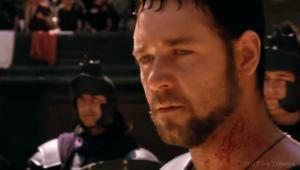Conventional Wisdom, Unconventional Results

But recently I was in the process of breaking in an Epson PowerLite Home Cinema 6500UB projector for an upcoming review in the print edition of Home Theater. Projection lamps tend to be a work in progress until they settle in, and I like to put as close to 100 hours on them as possible before getting serious. Instead of tying up my home theater space to do this, however, I placed the projector on a table in a smaller, adjoining room (a room often used for flat panel reviewing), fired the image onto the wall, and let 'er rip. This setup wasn't designed for serious viewing, much less serious evaluation, so I wasn't expecting much.
The source material was good (mostly high definition cable), and the projected image was just under 4' wide. But the wall not only had that mildly goose-bumpy texture common to nearly every piece of domestic sheet rock in the land, it was painted a mid-to-light, matte-finish brown. Or, as it's known in the right circles, medium beige.
What I saw was not what I expected. After a little tweaking to get the basic picture controls right (but no serious grayscale calibration—this was, again, a temporary setup) the picture was shockingly good. While the "wall gain" was clearly less than 1.0, the relatively small image was not only plenty bright in the dark, but also highly watchable on most material in more typical (but not sun-bright) room lighting. And from ten feet away I could not spot the wall's texture.
The beige wall color was apparently neutral enough to work well; the tint had no obvious effect on the image. White looked white, flesh tones were believable. Flashier colors such as orange or blue would probably not have been nearly so innocuous. I was also surprised at how good the blacks were, even with so small an imagewell-deserved kudos here to the Epson projector.
Overall, the result was so impressive I spent two long and late evenings watching a wide range of HD and SD material with virtually no complaints. With the caveat that screen shots are never a perfect representation of the real thing, the image at the top of this blog is of a film trailer on cable HD as shot directly from the on-wall projection. Apart from slight cropping and exposure correction, it was not processed in any way.
Nothing in this anecdotal experience refutes the need for a good screen to get the best out of any projector, particularly with a larger image. And I don't Stewart Filmscreen to announce a new BeigeHawk model any time soon. But as a temporary measure you might be surprised at how good a projected image can look when aimed at a humble patch of painted sheetrock.
An audio-related observation also came out of this. At present, the audio system in this small room is a simple 2-channel setup, since there are sometimes as many as three different sets under review in this 13' by 16' space, making a 5.1-channel system too cumbersome to deal with. At the time of this experiment, the two speakers flanked a flat-panel display in the middle, with the on-wall projected image to the left of the left speaker and another flat panel on the right of the right speaker.
You would expect that this setup would produce a serious spatial shift when watching anything but the center screen. But it didn't. With the center display in use, the soundstage was, as expected, anchored to the screen. But when I viewed the left display alone, the left speaker (the one closer to the left display) appeared dominant. And when I viewed the right image, the right speaker (closest to the right display) sounded louder. In neither case did the overall audio image appear to shift as much as might be expected from the physical position of the speakers. The visual senses here dominates the obvious audio disconnect.
The home theater game is full of surprises. We don't always see, or hear, what we expect.

























































